NEWS FLASH - The outright world speed sailing record was smashed this afternoon (November 24) by Paul Larsen in the Vestas Sailrocket 2 with the astonishing time of 65.37 knots. (75.23 mph - 121.06 km/h). See Paul's blog for the very latest as it happens.
The below article was posted just a few hours before the latest new record was run and has not been changed.
In a spectacular week for sailing, more than a dozen world speed sailing records have been broken at two different venues in Namibia. The outright speed sailing records for both 500 meters (59.38 knots) and one nautical mile (55.32 kts) were set in Walvis Bay by Australian Paul Larsen and the British-designed, inclined-rig hydrofoil Vestas SailRocket 2. Simultaneously, 600 km away, the annual Luderitz Speed Challenge has seen nine world outright speed records for sailboards established in just a week, including surpassing 50 knots (92.6 km/h) and 60 mph (52.14 kts). The breaking of world records is almost certain to continue over the coming weeks, with Larsen focussed on breaking the 60 knot (111.12 km/h - 69.05 mph) barrier and the now legendary Luderitz Speed Challenge continuing until December 16, with kiteboarders joining the event on December 3.
In a spectacular week for sailing, more than a dozen world speed sailing records have been broken at two different venues in Namibia. The outright speed sailing records for both 500 meters (59.38 knots) and one nautical mile (55.32 kts) were set in Walvis Bay by Australian Paul Larsen and the British-designed, inclined-rig hydrofoil Vestas SailRocket 2.
Simultaneously, 600 km away, the annual Lüderitz Speed Challenge has seen nine world outright speed records for sailboards established in just a week, including surpassing 50 knots (92.6 km/h) and 60 mph (52.14 kts). This article covers not just the Vestas Sailrocket 2 records, but all of the Lüderitz Speed Challenge records of the last week, including Anders Bringdal's remarkable 51.34 knot run on an over-the-counter sailboard.

The breaking of world records is almost certain to continue over the coming weeks, with Larsen focused on breaking the 60 knot (111.12 km/h - 69.05 mph) barrier and the now legendary Luderitz Speed Challenge which continues until December 16, with kiteboarders joining the event on December 3. Lüderitz is a significant event for many reasons, the foremost being that like Bonneville Speed Week which did the same for land speed records, the event represents the democratization of speed sailing record attempts.
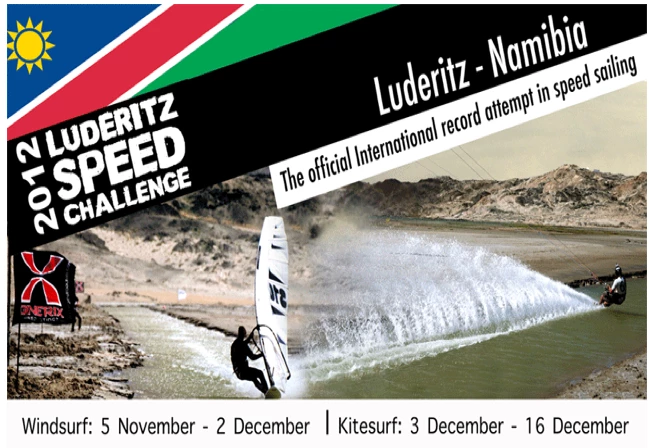
The Lüderitz Speed Challenge is an annual speed sailing event, first held in 2007 in Lüderitz, Namibia. The event is organised by ESF Events, managed and owned by Frederic Dasse and French kitesurfer Sebastien Cattelan, and is observed by the World Sailing Speed Record Council (WSSRC) and the International Sailing Federation (ISAF). This year sees the event held on a new man-made course which has thoroughly vindicated itself with a plethora of new records and many more almost certain to come over coming weeks.
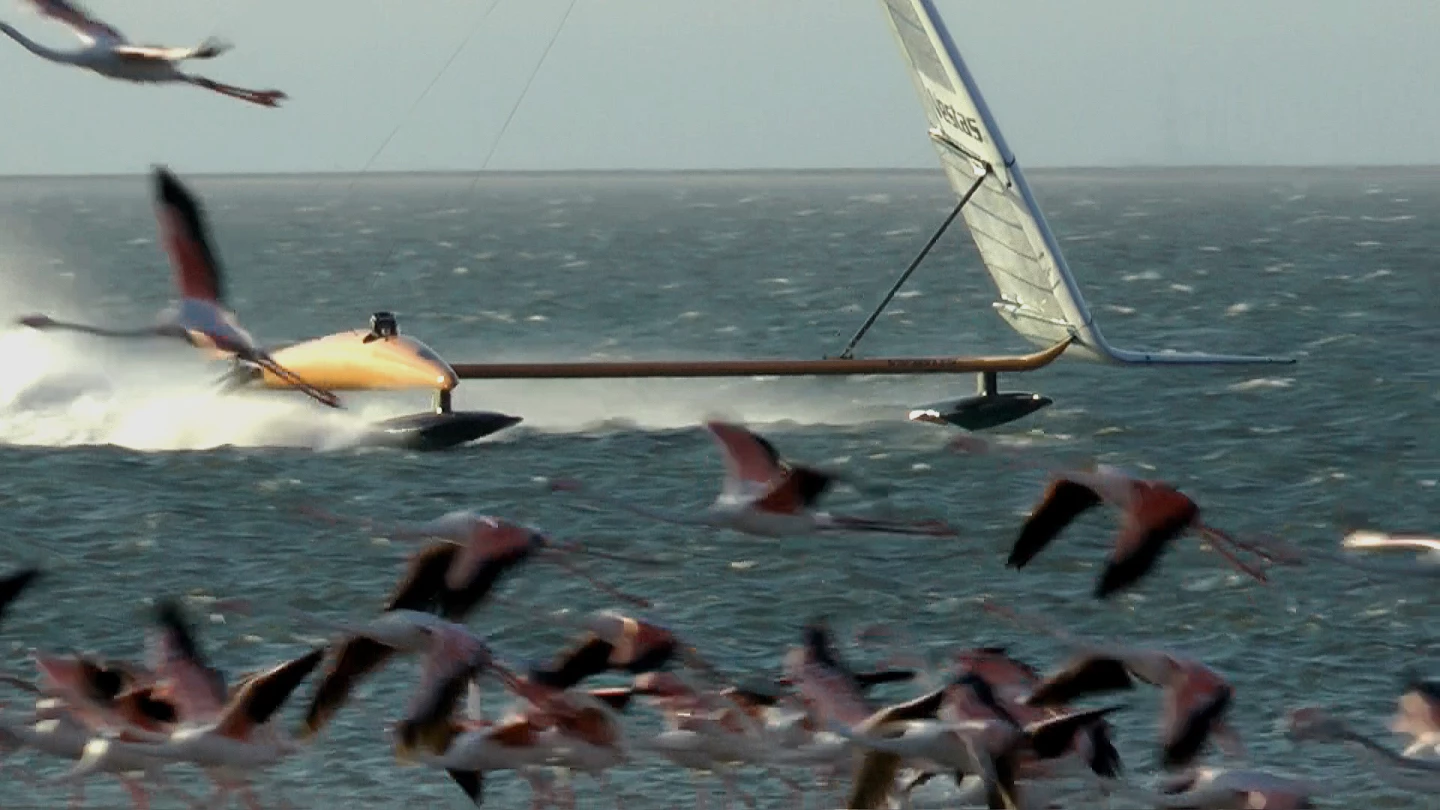
The new outright world speed sailing record
Australian Paul Larsen, sailing the British-designed and -built Vestas SailRocket 2, an inclined rig Hydrofoil, set a new 500 meter speed sailing record last Friday (Nov 16) with a 59.23 knot run in Walvis Bay, Namibia.
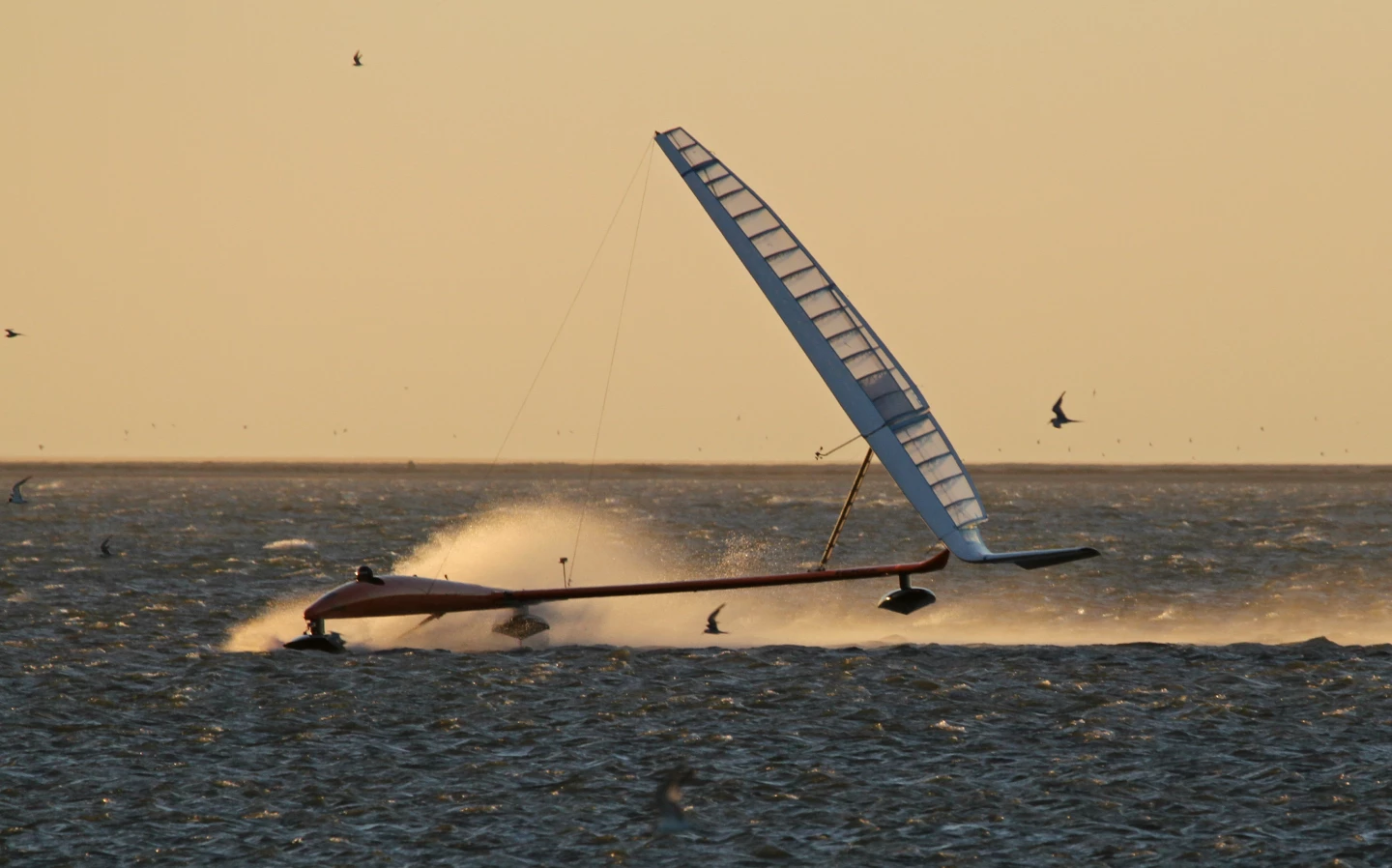
Last Sunday (Nov 18, 2012), Larsen set a new record for the nautical mile at 55.32 knots while pushing the 500 meter record to 59.38 knots.
Both of the Vestas Sailrocket team's technical leads, being Sailrocket 2's designer Malcolm Barnsley and George Dadd, flew from the U.K. to join the team in Namibia two days ago, with a view to being on hand for what are expected to be further record breaking feats, with the action set to begin again on Saturday, November 24, Namibian time. Interested parties can follow Paul and the team live on Twitter.

All three records (one on Friday and two on Sunday) are still awaiting World Speed Sailing Record Council (WSSRC) ratification, though a run November 12 (2012) which saw Larsen extend his own 49.19 kt World “B” Division (150-235 square feet of sail) Speed Sailing Record (set last year at the same venue) to 54.08 kts, has already been ratified.
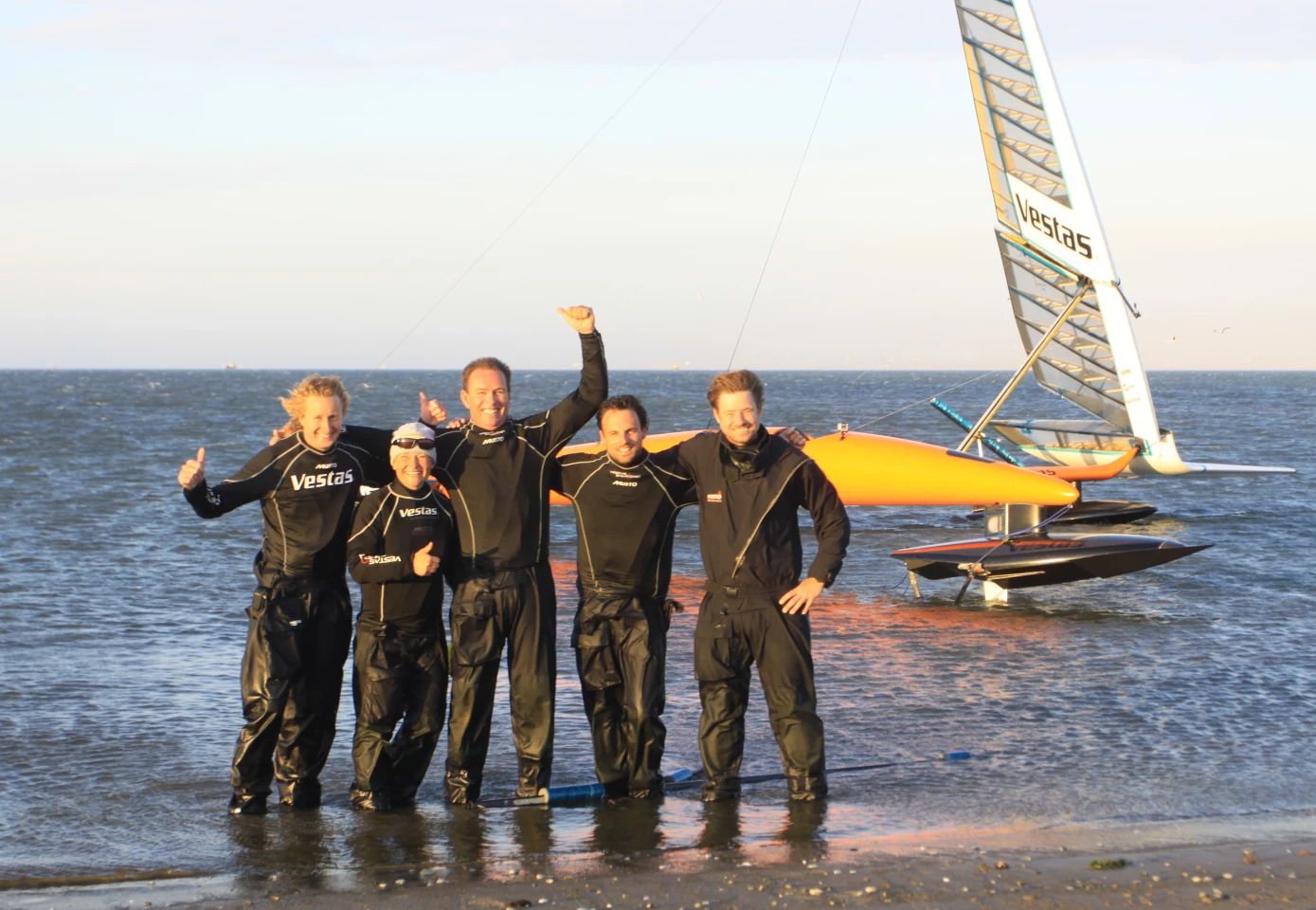
As the name suggests, the Vestas Sailrocket 2 is the second Sailrocket, having been launched in March, 2011. The boat was designed by Malcolm Barnsley and built in the Vestas R&D facility on the Isle of Wight (UK).
The first Vestas Sailrocket became the fastest sailing boat on the planet on December 3, 2008 with a 500 meter average of 47.366 knots, though it was still shy of the outright speed sailing record of 49.09 knots established earlier that year (March 5) by the windsurfer of Antoine Albeau.
During the 47.366 knot run, Larsen reached an unofficial peak speed of 52.22 knots, but on the very next run, it performed some death-defying acrobatics and destroyed significant parts of the boat.
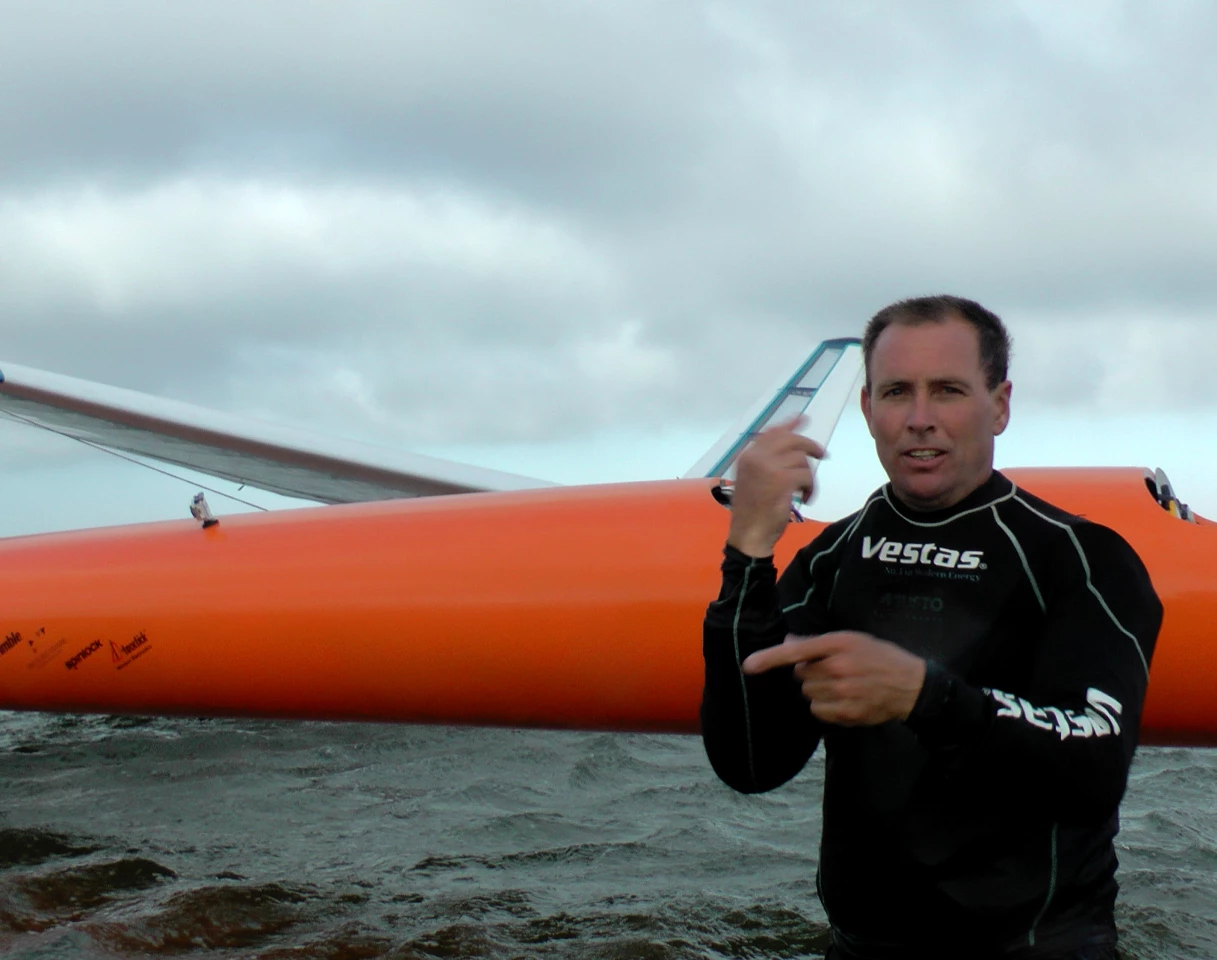
Larsen wrote in his blog on September 9, 2009, reflecting not so much on the dark cloud of the disaster as the silver lining it presented: "It may well turn out that the timing of the last failure was perfect. With a destroyed steering system and without the distraction of going sailing, Malcolm, George and I sat down with a clean sheet of paper to completely redesign Vestas Sailrocket's control systems."
His prophecy turned out to be very accurate, as the extraordinary Sailrocket 2 now appears to have brought all the technologies together to push past the 60 kt mark.
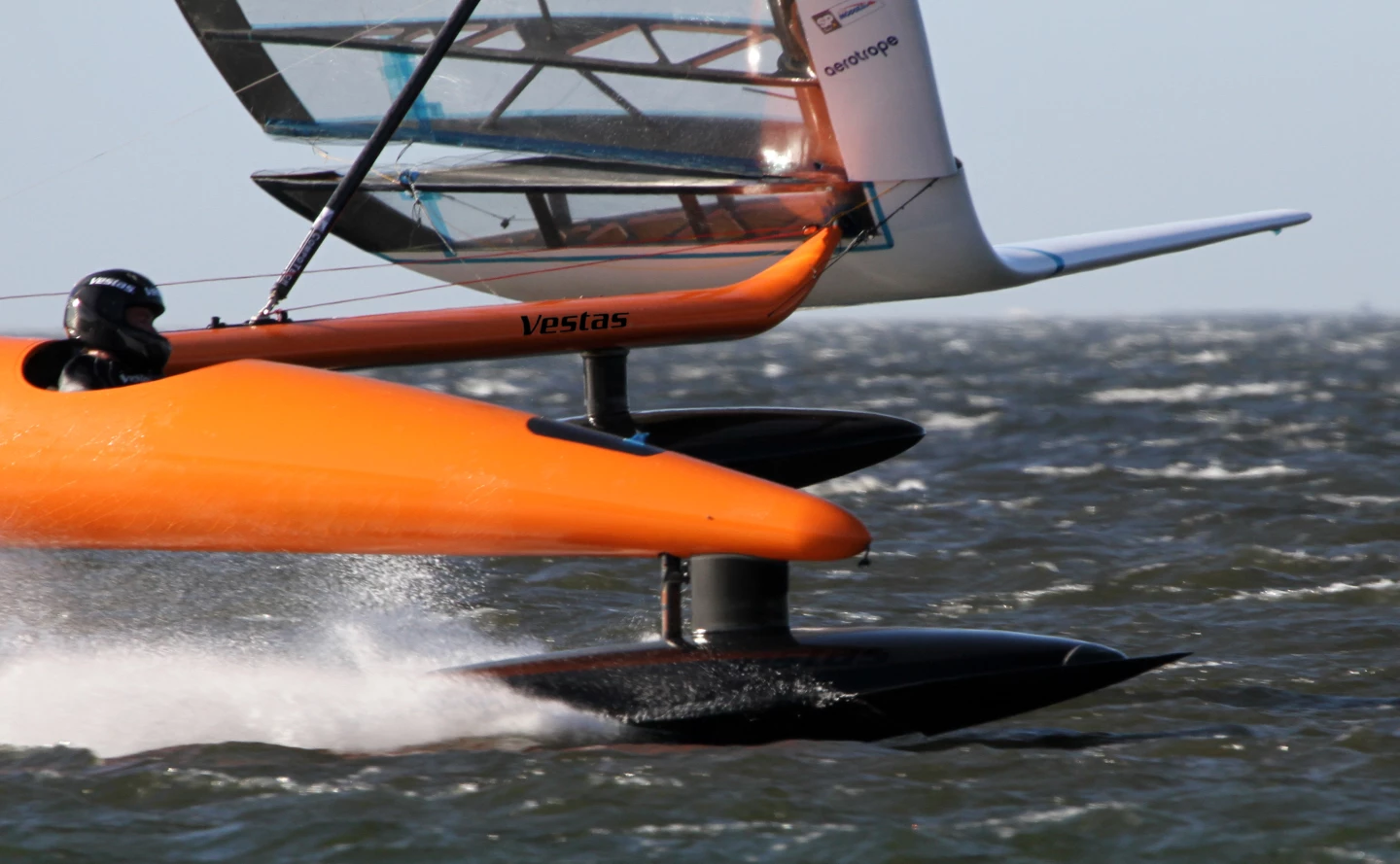
The main fuselage and beam of the Vestas Sailrocket 2 are angled at 20 degrees to the direction of travel so the boat points directly into the direction of the ‘apparent’ wind at high speed to both reduce drag and increase stability.
The entire boat including rigging has an aerodynamic drag equivalent to that of a 74 cm diameter sphere and is capable of a three to one boat speed to wind speed ratio.
Larsen runs a blog covering his exploits in the Vestas Sailrocket 2 team and it's well worth a read. His latest posting covers the record run itself and it is quite extensive ... highly recommended.

For those interested in the design and array of technologies used in making the fastest sailing boat on the planet, there's no shortage of detail on the site, with detailed explanations of the objectives based on the lessons of the first Vestas Sailrocket, the subsequent design criteria, and a range of topics such as "power without overturning", "living with cavitation", "evolution from VSR1", the construction, dimensions, details of the Wing-Sail and more. It's actually surprising that so much information is freely available in such a competitive endeavor.
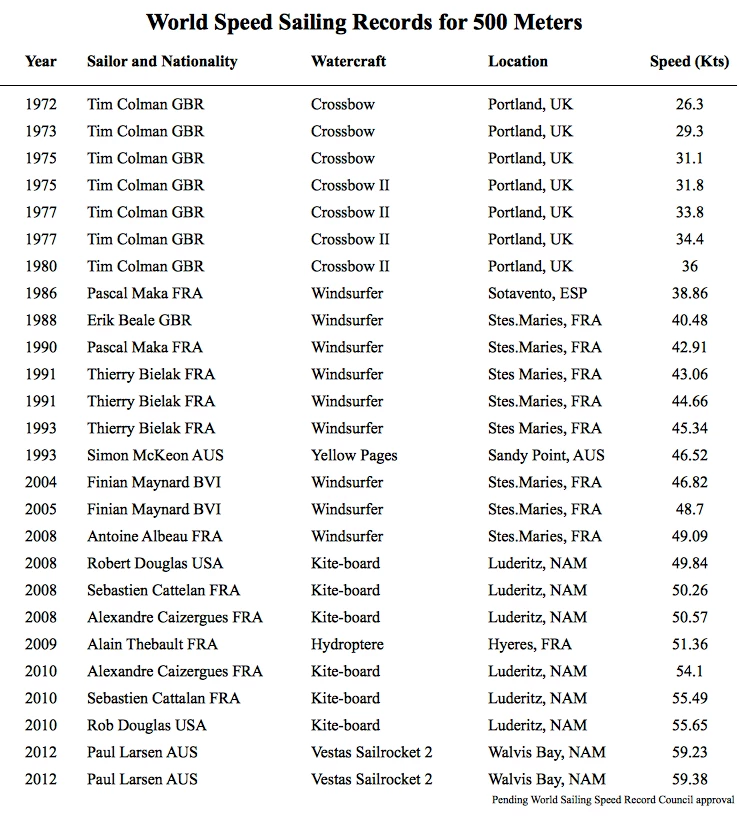
The speed sailing records and how they fell
Four decades ago, in 1972, the World Speed Sailing Record Council (WSSRC) was established by the International Yacht Racing Union (now the International Sailing Federation) to provide impartial ratification of speed attempts by sailing watercraft (it doesn't cover ice- or land-based sailcraft).
Initially, it was decided to base such speed ratifications on a one-way leg of exactly 500 metres. Since then, the brief of the WSSRC has expanded, and a range of records are administered by the Council - perhaps most significantly, the council has legitimized a challenge to mankind, and the old adage that "competition improves the breed" has proven to be true once more.

Tim Colman (later to become Sir Timothy Colman for his exploits), was the first to claim a world record with his Proa, Crossbow.
Colman set about writing the record books with Crossbow and his subsequent catamaran Crossbow II, setting the first seven outright world speed sailing records, beginning in 1972 with 26.3 knots in Crossbow, and finishing in 1980 with a run of 36 knots which saw him hold the title until 1986 when the era of the windsurfer began.
The era of the windsurfer Pt 1
The first windsurfer to take the outright speed sailing title was Frenchman Pascal Maka in 1986, the first of 11 French world speed sailing records established on sailboards, aided significantly by the purpose-built "French Trench" near the French Mediterranean coastal town of Saintes Maries de la Mer.
The Saintes Maries de la Mer Speed Canal (AKA "the Canal") is 1,100 metres long and 30 metres wide and was specifically built and orientated so that speed windsurfers could take advantage of the famous Mistral wind which blows off the Mediterranean.
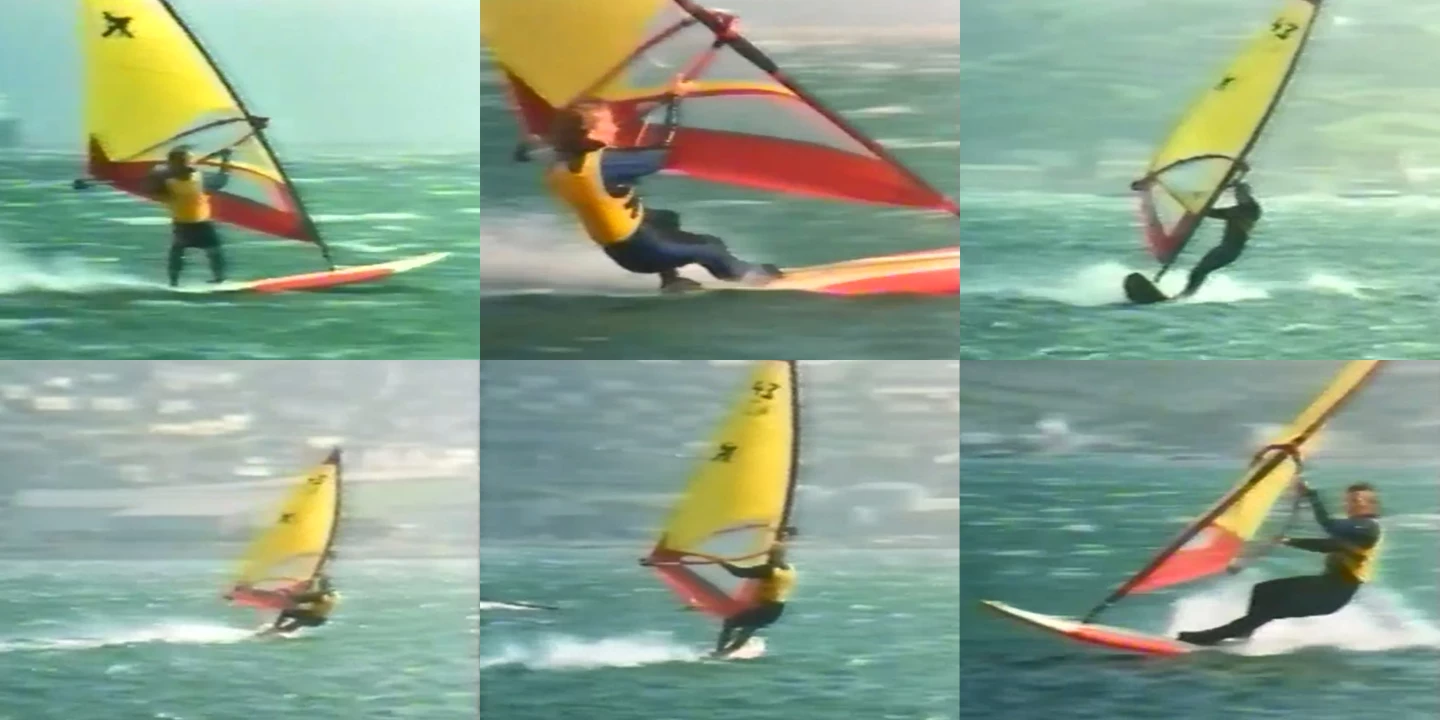
The above images were clipped from this video covering the 1981 Weymouth Speed Trials. Jurgen Honscheid was the fastest sailboarder in the world in 1981, though sailboarding was still in its infancy and his speed of 24.75 knots was roughly two-thirds of the speed of Tim Colman's Crossbow II which held the outright speed sailing record at that time. As can be seen, the humble sailboard has progressed rather rapidly, more than doubling in just three decades.
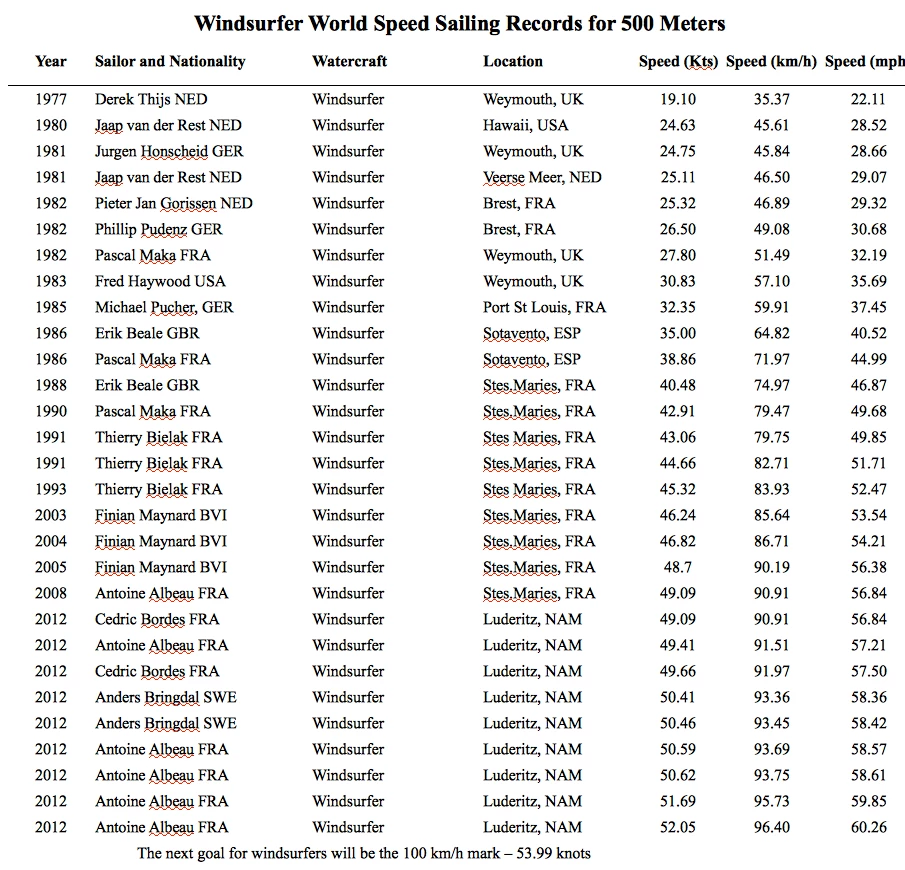
Erik Beale of Great Britain used the "French Trench" to become the first sailor to broach the 40 kt mark in 1988, and with the exception of Simon McKeon's 1993 46.52 kt record set in the radical trimaran Yellow Pages Endeavour at Sandy Point in Australia, "The Canal" was the venue for seven of the next eight world speed sailing records - all of them on windsurfers.
Beale's record was subsequently eclipsed by Maka again, then Thierry Bielak set three consecutive records on the Saintes Maries de la Mer Speed Canal before Simon McKeon wrested the title back from the sailboard for the sailboat, though traditional sailors might not recognise the much closer relative of the genre.
Yellow Pages Endeavour

The Yellow Pages Endeavour was a radical trimaran designed and built in Melbourne, Australia. The Yellow Pages Endeavour achieved 46.52 knots (53.5 mph or 86.2 km/h) at Sandy Point, near Victoria's Wilson's Promontory with Simon McKeon at the helm.
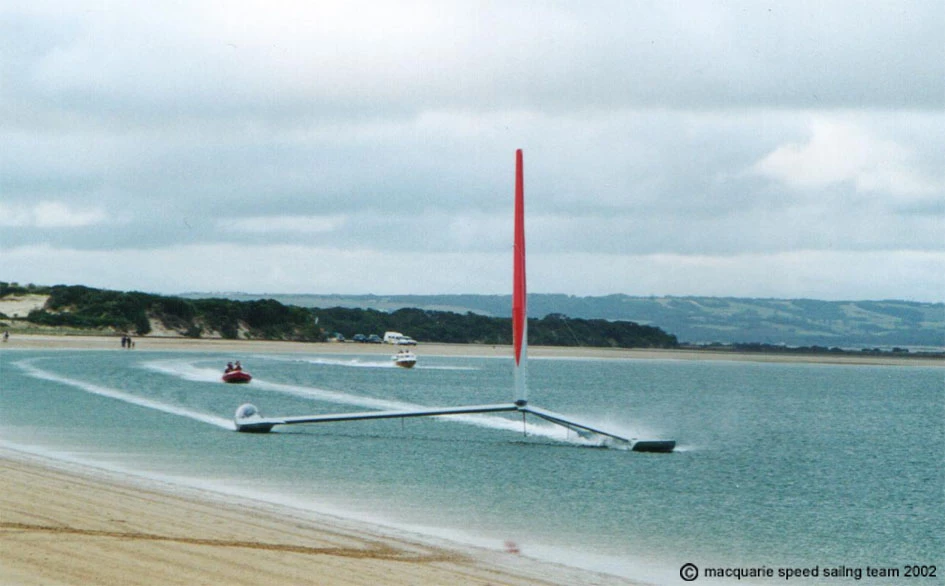
McKeon went on to pilot the subsequent Macquarie Innovation project which became the fastest sailboat in the world briefly in 2009 and significantly, the first sailboat to exceed 50 knots. McKeon was named "Australian of the Year" in 2011.
The era of the windsurfer Pt 2
One might reasonably have expected that high-tech, big-dollar, purpose-built sailboats would retain and extend the world outright speed sailing record from that point forth, and it seems that perhaps the sailboarding fraternity thought likewise, as Yellow Pages held the outright 500 meter world speed sailing record for more than a decade (from October, 1993 to November, 2004), despite its narrow margin of just 1.18 knots over the previous record.
Then along came sailboarder Finian Maynard, who used the French Trench to push sailboarding back to the forefront of speed sailing by just 0.3 knots (to 46.82 knots) in 2003, and then extending that record again with a more substantial margin in 2004 to 48.7 knots.
These days, Maynard works with Dan Kaseler at Avanti Sails where he continues in both product development whilst competing, at the same time as holding the title of General Manager.
Frenchman Antoine Albeau was the last windsurfer to hold the outright speed sailing record when he used "The Canal" to record a speed of 49.09 knots in 2008, a speed that has only been exceeded on a windsurfer in the last week, albeit twenty times.

Albeau's record will almost certainly be the last outright world sailing speed record held by a sailboard, as a policy established in 2005 had meant that kite-boarders were not eligible to hold the Outright World Sailing Speed Record but the WSSRC removed this policy in 2008 catalyzing a raft of new activity, and kiteboards are clearly faster than sailboards.
The era of the kiteboard Pt 1
The second Luderitz Speed Challenge for both kiteboards and sailboars was held in September/October 2008, and with kiteboards suddenly eligible, the outright World Speed Sailing Record began to progress rapidly.
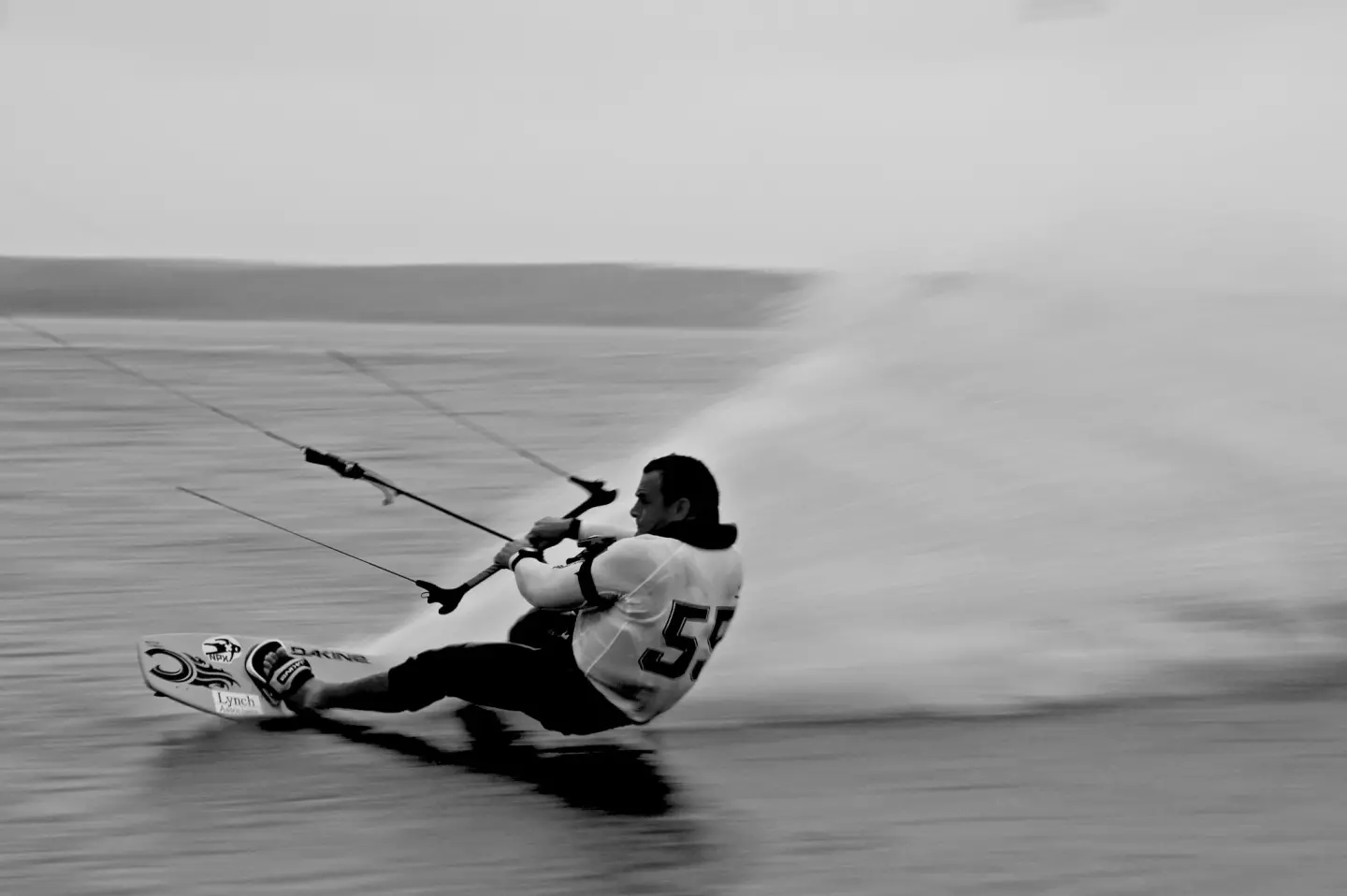
American Robbie Douglas became the first kiteboarder to hold the outright World Speed Sailing Record with a run of 49.84 knots (92.30 km/h) during the Luderitz event on September 20.

Then Frenchman Sebastien Cattelan pushed it above the milestone figure of 50 knots with a run of 50.26 kts on October 3. Like the four minute mile for runners before it, once the barrier had been breached, it didn’t take long for it to be broken again and again.

Another French kite-boarder, Alexandre Caizergues pushed the record to 50.57 kts on October 4. Significantly, Douglas also ran over 50 knots before the 2008 Luderitz Speed Challenge was over, establishing the "big three" of kiteboarding
New thinking yields the radical l'Hydroptere -
The French l'Hydroptere is the most advanced sailing boat on Planet Earth at this moment.
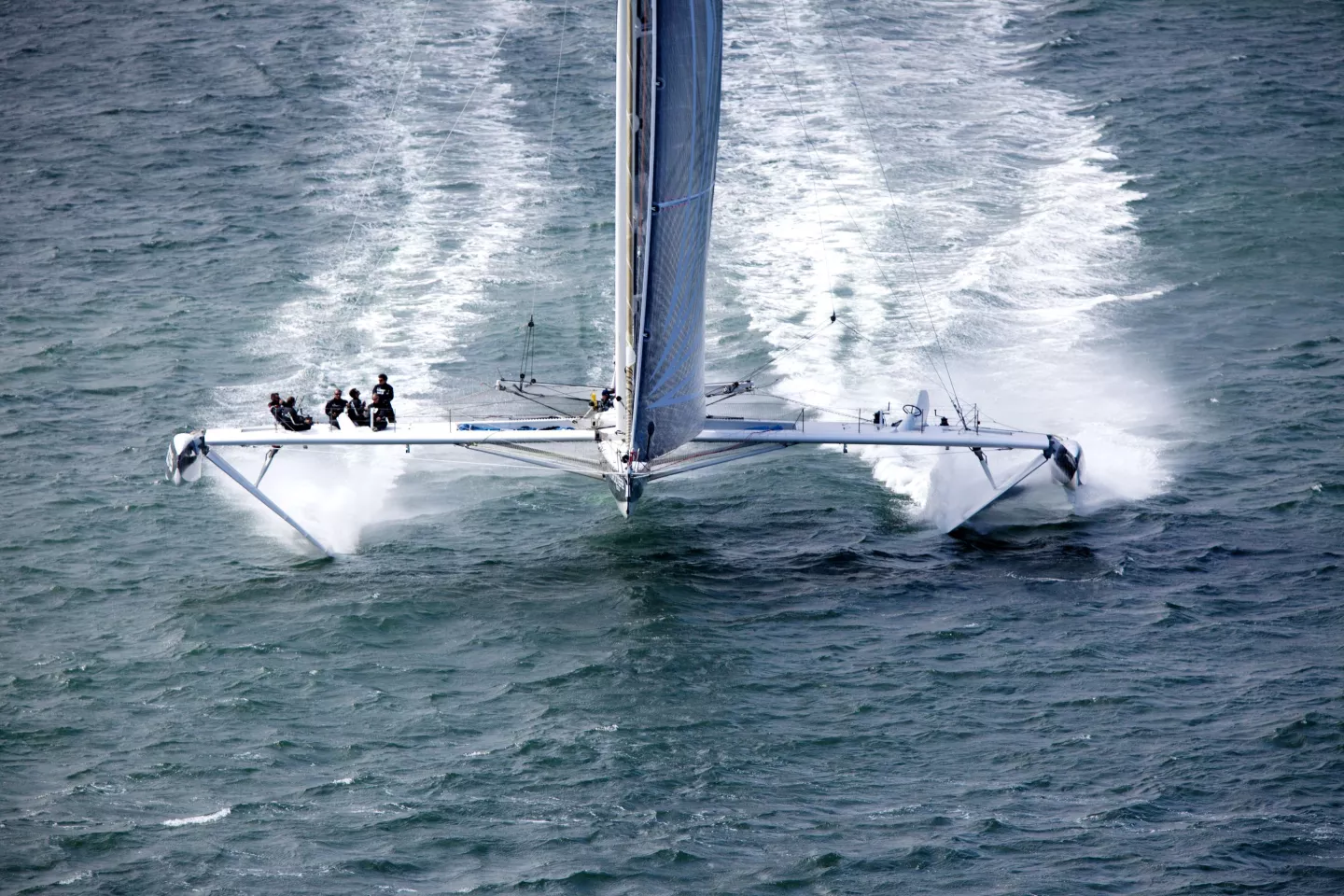
The work of Alain Thébault and the late Éric Tabarly, the multihull hydrofoil l'Hydroptère project began in 1984, borrowing heavily from aeronautical technologies.
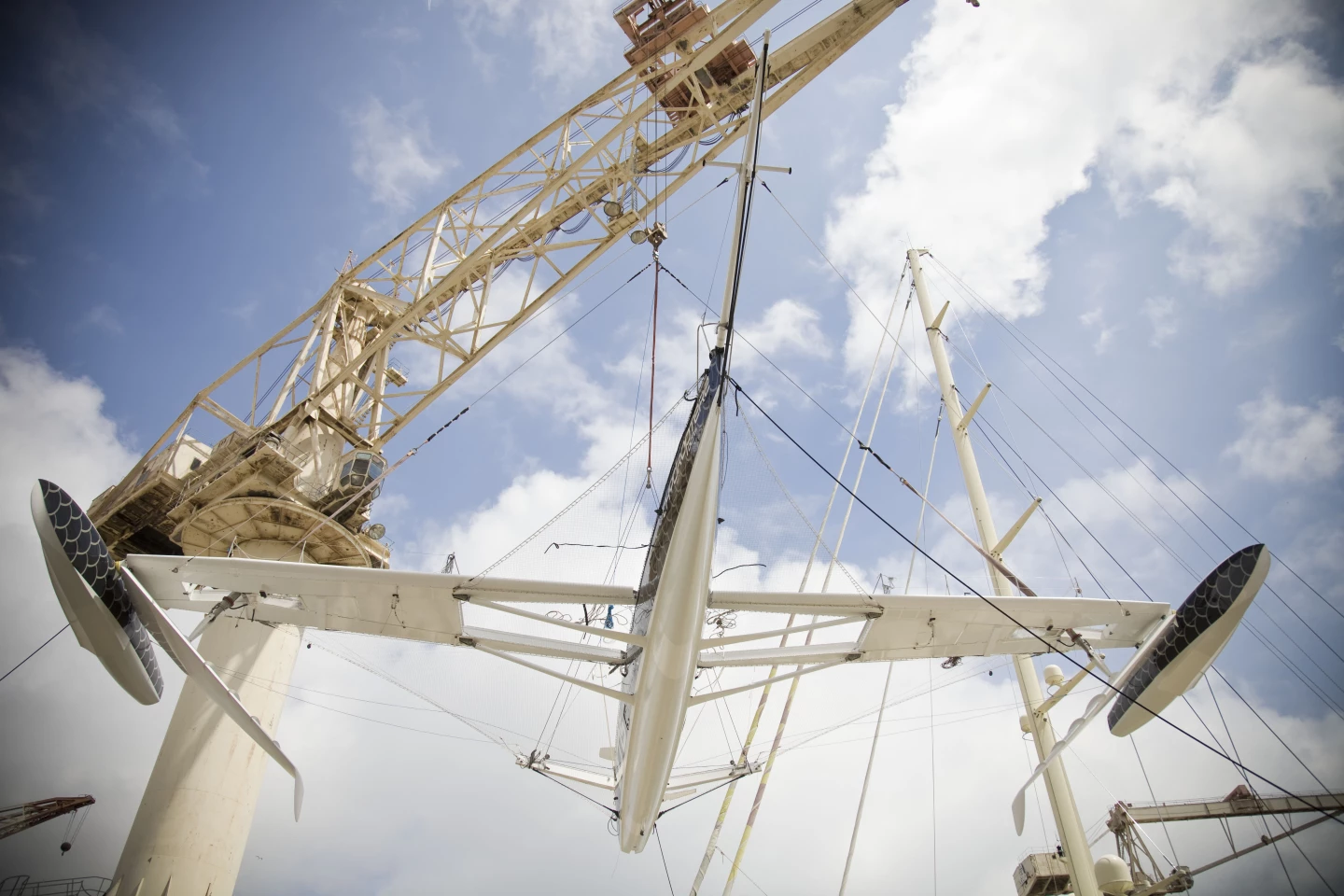
Experimentation was initially confined to a one-third scale model until l'Hydroptère was launched in 1994. In 2005, the project came under the patronage of Swiss banker, Thierry Lombard, enabling the cash-starved Thébault the liquidity to develop his yacht for speed sailing and the first major achievement of l'Hydroptere became the crossing of the English Channel which it did at a 33 knot average the same year.

From there, l'Hydroptere has gathered all before it, taking the outright World Speed Sailing Record for a nautical mile in 2007, and then re-setting the mark a futher three time.
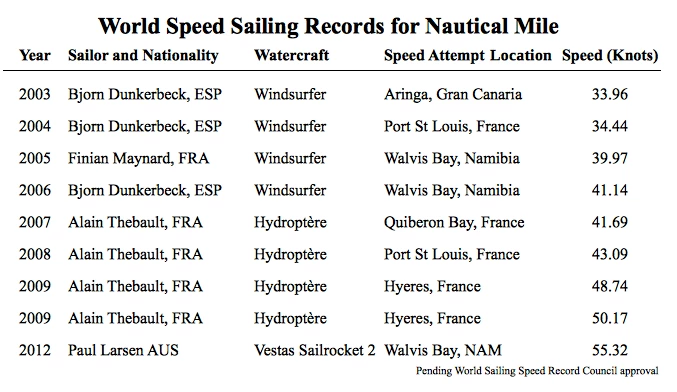
In September 2009, Thébault and his crew managed to break the outright 500 meter speed record with a run of 51.36 knots.
It might not be as fast as the Vestas Sailrocket 2 over 500 metres or one nautical mile in highly specific and extremely rare, flat-water, high-wind conditions, but it can achieve close to those speeds in open water, across oceans and it can sail in any weather.
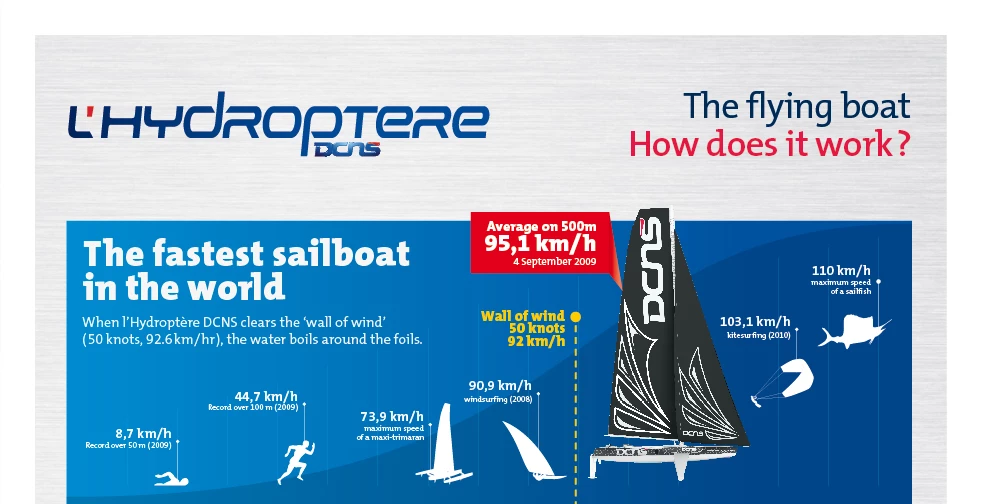


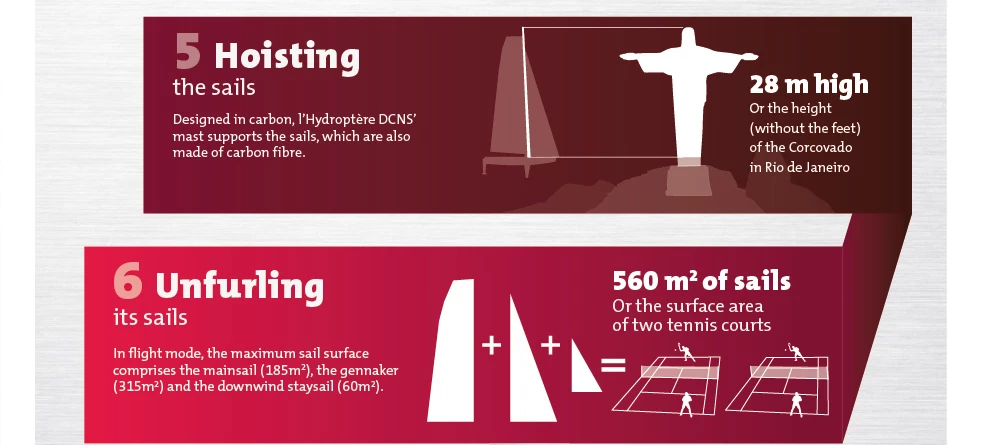
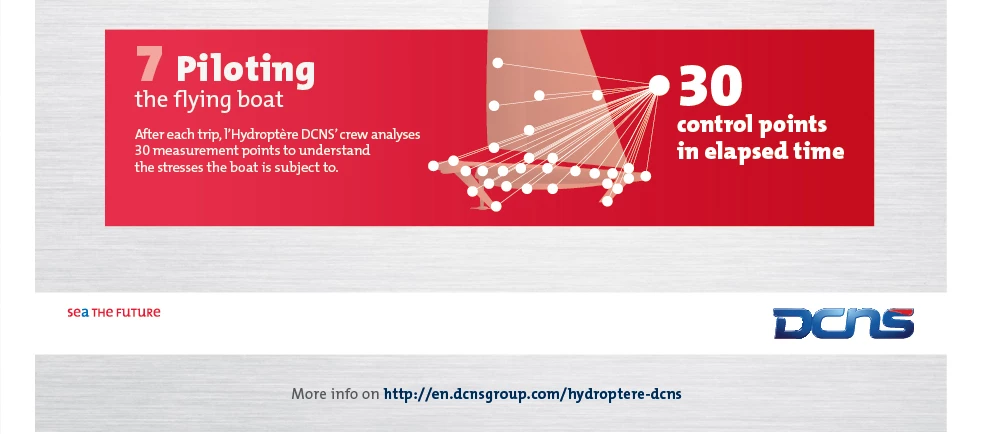
The era of the kiteboard Pt 2
Once more, it might have been reasonably expected that with l'Hydroptere on the water, the outright World Speed Sailing Record would become the exclusive domain of big-dollar teams, but the Luderitz Speed Challenge of 2010 saw five kiteboarders exceed Hydroptere's record, with the big three all taking turns at holding the title, with American Robbie Douglas finally prevailing to push the outright World Speed Sailing Record to an astonishing 55.65 knots using a Cabrinha Switchblade kite and a custom board built by Mike Zajicek.
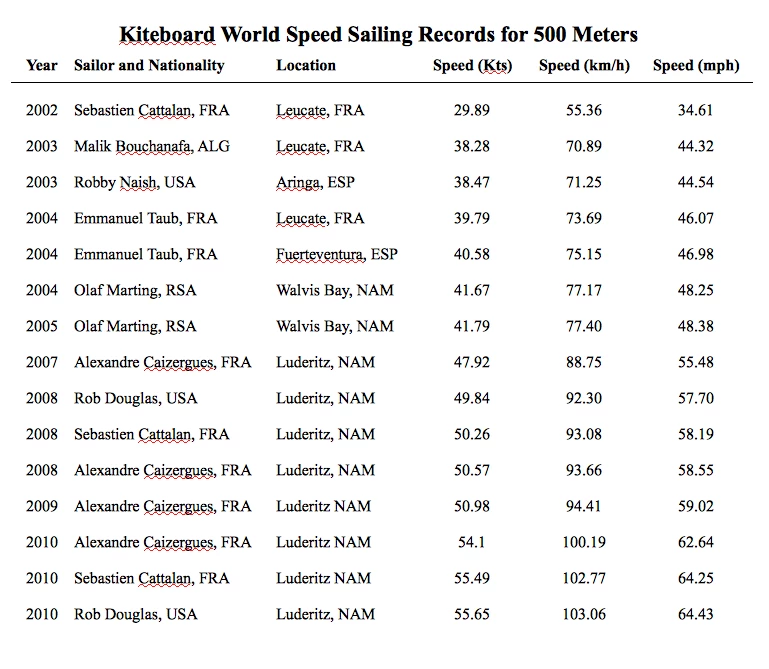
Douglas' record has now been broken by Paul Larsen and the Vestas Sailrocket 2, though Douglas, Alexandre Caizergues and Sebastien Cattelan will all get an opportunity to attack Larsen's record over the next few weeks on the new Luderitz course and if the efforts of the windsurfers over the last week is any indication, Larsen's record is far from safe.
In the last week, five windsurfers (Anders Bringdal 51.34 kts, Patrick Diethelm 50.49 kts, Jurjen Van der Noord 50.41 kts and Cedric Bordes 50.17 kts and Antoine Albeau 52.05) have exceeded the 50 knot mark when the fastest speed ever recorded by a sailboard previously was Antione Albeau's 49.09 kts in 2008. A similar improvement for the kiteboarders would bring Paul Larsen's new outright record within a gnat's whisker.
The accessibility of sailboarding and kiteboarding
Perhaps the most interesting aspect of the Luderitz Speed Challenge is the speed being achieved by people with over-the-counter equipment costing hundreds rather than the millions of dollars spent on the high tech sailboats which just narrowly shade them for the outright world speed sailing record.
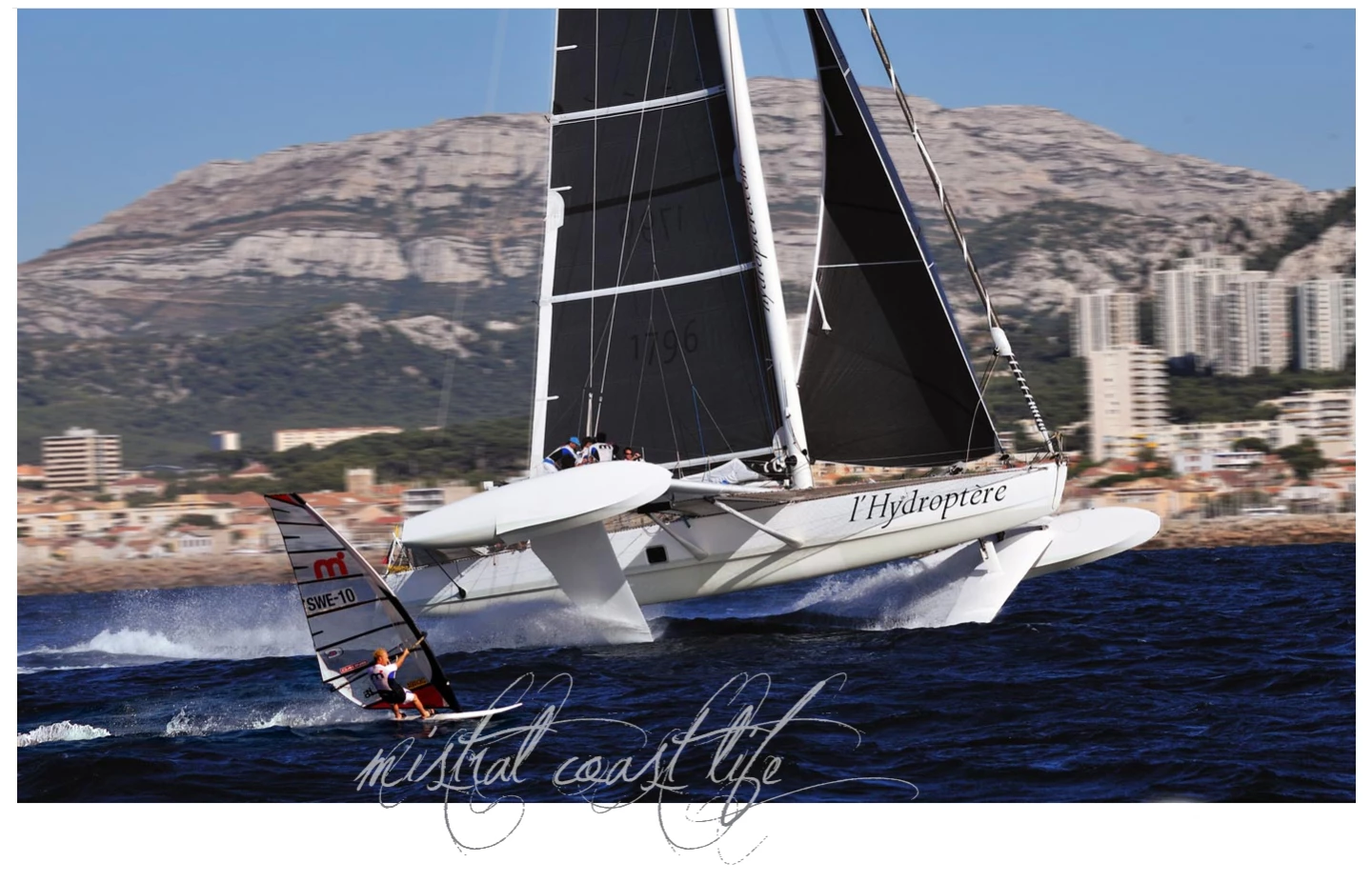
Anders Bringdal of Sweden is just fractions of a second behind the fastest sailboarder in history, Antoine Albeau, and many are referring to the sailboarding segment of the 2012 Luderitz Speed Challenge as "the Antoine and Anders Show".

Bringdal's achievements are astonishing when it is considered that he has achieved 51.45 knots over 500 meters on a standard sailboard, emphasizing the accessibility of the sport to the average person.
Anders is using a production Mistral 41cm board, an NP Evo 5.8m sail and a 20cm Gasoil fin.

Zara Davis, the fastest woman sailboarder in history is also using a production Mistral Speed 41cm board and a stock 2012 5.5m Simmer SCR sail.



















































































































































































